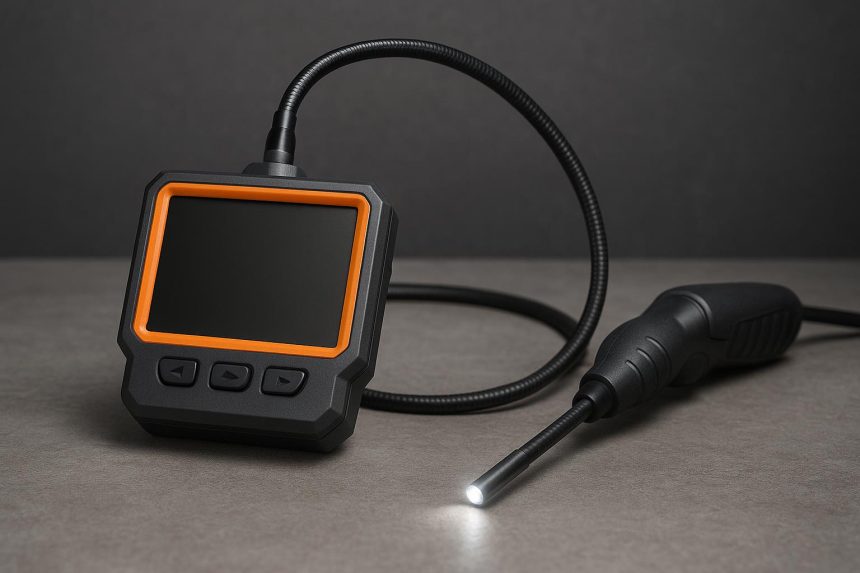In many industries, the most critical components of a machine or system are often hidden from view. How do you inspect the inside of a car engine cylinder, an airplane wing, or a drainage pipe without completely taking it apart? The traditional answer was a time-consuming, expensive process of disassembly and reassembly. Today, a modern and much more efficient solution exists in the form of a video borescope.
A video borescope, sometimes called a videoscope or inspection camera, is essentially a specialized tool with a very small camera on the end of a long, flexible or rigid tube. It allows an operator to remotely view and inspect internal, hard-to-reach areas.
The purpose of this tool is to provide a live, real-time video feed from within an object, enabling a wide range of inspections for maintenance, quality control, and safety, all without the need for destructive disassembly. It has become an essential device for engineers and technicians across a variety of fields.
Components of a Video Borescope
A video borescope is made up of a few key components that work together to provide a clear view of an internal space.
Probe/Insertion Tube
This is the long, slender part that is fed into the area being inspected. Depending on the model, this tube can be either flexible to navigate around bends and corners or rigid for straight, direct access. Probes come in various lengths and diameters, allowing them to fit into a wide range of tight spaces, from a narrow pipe to a large engine cylinder.
Camera/Light Source
At the very tip of the probe are the most critical components: the camera and a light source. The camera itself is a miniature imager, often no larger than a pencil eraser, that captures the video feed. To ensure the image is clear, especially in dark, internal spaces, the camera is surrounded by powerful LED lights. These lights illuminate the inspection area, making it possible to see cracks, debris, or other details with clarity.
Display Screen
The video signal from the camera is then sent to the display screen. This is a small, portable monitor that shows a live, high-resolution video feed of what the camera is seeing. Most modern borescopes have a full-color screen that can be easily held or mounted, making them convenient for use in the field.
Control Handle
The entire device is controlled by a handle. This is the user interface where you hold the borescope and operate its functions. The handle typically includes buttons for turning the light on, capturing images or videos, and, on more advanced models, controlling the camera’s movement.
How a Video Borescope Works
The process of using a video borescope is straightforward and highly effective.
Step 1: Inspection
The inspection begins with insertion. The operator carefully guides the flexible or rigid probe into the area that needs to be inspected. This could be an opening in a machine, a vent in a wall, or an access point in a pipe. The slim diameter of the probe allows it to enter spaces that are completely inaccessible to a person.
Step 2: Illumination and Imaging
Once the probe is in place, the built-in light source at the tip is activated. The bright LED lights instantly illuminate the dark, confined space, allowing the tiny camera to capture a clear image.
Step 3: Real-Time Viewing
Next, the camera sends a live video signal up through the probe and into the display screen. The operator watches this real-time video feed, moving the probe to explore the area and look for any signs of damage, blockages, or other issues.
Step 4: Articulation
On more advanced video borescopes, an added feature called articulation makes the process even more effective. Unlike a basic model where the probe can only be pushed and pulled, an articulated borescope has a tip that can be steered or bent using a joystick on the control handle.
This allows the operator to steer the camera around corners, look back at features, or get a clear view of a particular point of interest without having to remove the entire probe and reinsert it. This steerability is a major advantage for complex inspections.
Key Features and Benefits
A video borescope’s design provides a number of important features and benefits that make it an invaluable tool.
Portability
Most video borescopes are compact, handheld devices that can be easily carried to a job site. This allows technicians to perform inspections directly where the problem is located, whether it’s on a large piece of industrial machinery or an airplane on the tarmac.
Image and Video Capture
Many models come with internal memory or a slot for an SD card, allowing the user to record the live video feed or take still photos. This is extremely useful for documentation, as these recordings can be used for later analysis, shared with colleagues, or included in inspection reports.
Articulation or Steerability
By being able to steer the camera tip, an inspector can navigate around internal obstacles and get a clear, head-on view of a defect that would otherwise be difficult to see. This reduces inspection time and improves the accuracy of the findings.
Non-Destructive Inspection
A video borescope allows you to visually inspect an internal component without having to take apart the entire machine. This saves a tremendous amount of time and money that would otherwise be spent on disassembly, labor, and potential reassembly issues.
Safety
Borescopes allow technicians to inspect potentially dangerous or hazardous environments, such as areas with high heat, radiation, or toxic substances, from a safe distance. This keeps human inspectors out of harm’s way while still providing the information they need.
Industries and Applications
Video borescopes are essential tools used in a wide variety of industries. Let us look at a few:
- Automotive: Mechanics use them to peer into engine cylinders through the spark plug holes to check for piston damage or carbon buildup, all without having to remove the engine head. They are also used to inspect transmissions and other mechanical components for signs of wear.
- Aerospace: Technicians use them to inspect aircraft engines for turbine blade damage, cracks, or foreign object debris that could pose a flight risk. Similarly, they are used to check airframes for corrosion in hard-to-reach areas.
- HVAC: borescopes are perfect for inspecting air ducts, vents, and pipes for blockages, mold, or leaks without tearing into walls or ceilings.
- Plumbing: Borescopes are ideal for locating clogs, leaks, or root intrusions inside drain pipes.
- Manufacturing: Borescopes are used for quality control, allowing inspectors to check for internal flaws in castings or to ensure that internal components of a product are properly assembled before it leaves the factory.
Conclusion
A video borescope is a powerful and versatile tool that has revolutionized the way we inspect internal spaces. With its long, slender probe, integrated camera, and real-time display, it provides a clear, non-destructive view of areas that were once impossible to see.
It allows technicians to capture images, navigate complex geometries with articulation, and avoid hazardous environments. This saves time, money, and most importantly, enhances safety. The video borescope is, thus, a modern, efficient, and indispensable device transforming maintenance and quality control across industries.
Lynn Martelli is an editor at Readability. She received her MFA in Creative Writing from Antioch University and has worked as an editor for over 10 years. Lynn has edited a wide variety of books, including fiction, non-fiction, memoirs, and more. In her free time, Lynn enjoys reading, writing, and spending time with her family and friends.















